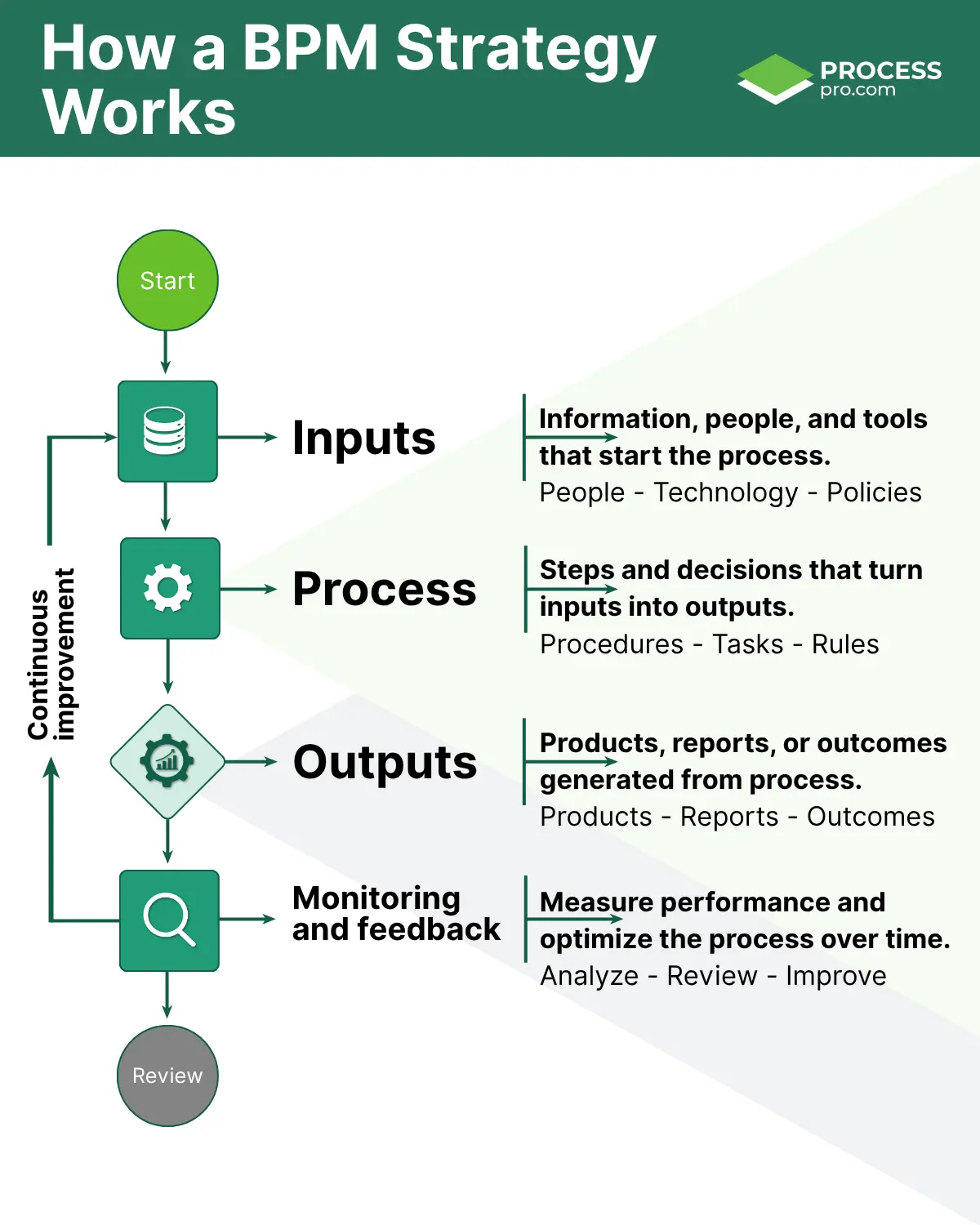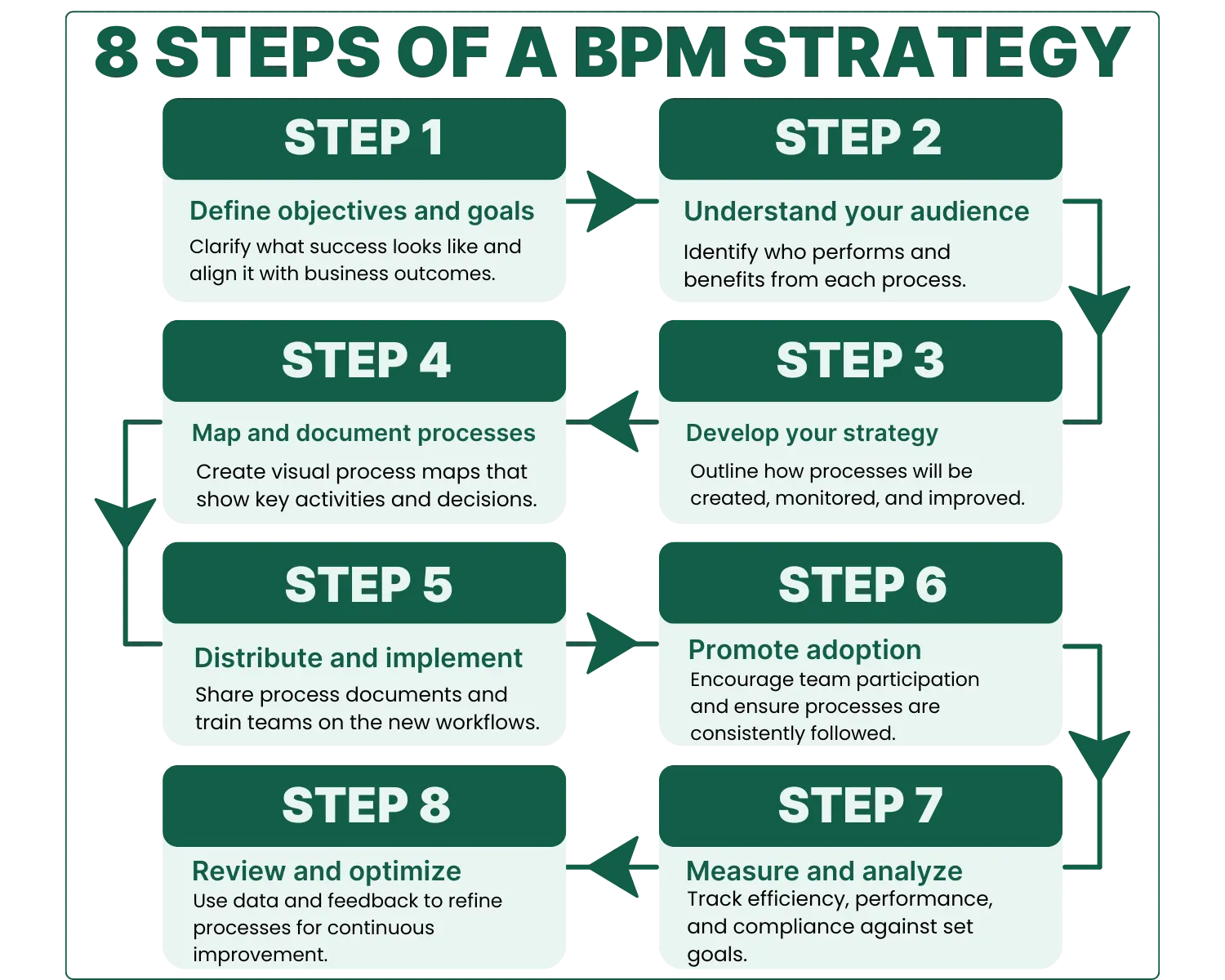Three months before a major audit, a financial services firm discovered its process documentation scattered across emails, folders, and spreadsheets. No one knew which version was current or who owned the updates.
Most organizations don’t struggle because they lack tools, they struggle because no one owns the process. A clear business process management strategy changes that, shifting operations from reactive fixes to proactive control.
This kind of chaos is common and costly. It leads to compliance failures in regulated industries and slows growth in expanding businesses.
At ProcessPro, we see this every day. When teams replace guesswork with governed systems, they reduce risk, move faster, and simplify compliance.
TL;DR – Business process management strategy
Here’s what a business process management strategy does, and why it matters.
- A business process management strategy standardizes how your business defines, executes, and improves its processes.
- It creates clear roles, reduces risk, and supports automation.
- Teams follow shared procedures, not scattered documents or memory.
- It supports better compliance, faster onboarding, and measurable improvement.
- ProcessPro gives you the tools to design, govern, and scale your BPM strategy from day one.
What is a business process management strategy
A business process management strategy is a documented framework for how your company identifies, manages, and improves its business processes. It gives teams clarity, aligns work to business goals, and allows leadership to govern process change.
Where SOPs or checklists describe tasks, a BPM strategy defines ownership, tracking, change control, and optimization over time.
Think of SOPs like printed directions to a destination. They get outdated fast. A business process management strategy is more like GPS, it adapts to traffic, gives live updates, and helps everyone stay on the same route.
Companies that apply business process management consistently report better customer experience, lower compliance risk, and smoother cross-functional operations.

Why a business process management strategy is different from SOPs and workflows
A business process management strategy is different from SOPs and workflows because it doesn’t just describe how tasks are done, it defines how processes are created, maintained, improved, and aligned with business goals.
SOPs are often static documents. Workflows might show task sequences. But they usually live in silos, lack ownership, and don’t adapt easily when your business changes.
Imagine building a house with only sticky notes for instructions. That’s what most businesses do with scattered SOPs and undocumented workflows. A BPM strategy gives you the blueprint, the tools, and the foreman to keep construction on track.
A BPM strategy fills those gaps. It gives you:
- A central structure to manage processes end to end
- Assigned owners, review cycles, and accountability
- Real-time visibility and change tracking
- Alignment between people, systems, and outcomes
It connects documentation to execution. It turns informal practices into governed systems.
Without a strategy | With a BPM strategy |
SOPs live in scattered folders | SOPs are linked to live process maps |
Teams use outdated instructions | Everyone works from the latest version |
No audit trail | Full version history and approval tracking |
Change depends on memory | Change is systemized and role-based |
A BPM strategy creates order, reduces risk, and gives your teams a reliable way to improve how work gets done, not just record it. For the teams using it, that order feels like relief: fewer fire drills, clearer roles, and more time for meaningful work.
The businesses that outperform their competitors aren’t the ones with the most detailed SOPs. They’re the ones that treat process governance as a living system, adaptable, measurable, and owned by everyone involved.
The importance of business process management strategies
Business process management strategies are important because they bring structure, clarity, and control to how your business operates. They help ensure that daily work supports bigger goals, and that critical processes don’t fall apart when things change.
A clear strategy helps every department, from HR and finance to compliance and customer service, work more efficiently and stay aligned with the business.
Here’s how:
- Reduces risk
Well-defined processes reduce the chance of costly mistakes, failed audits, or noncompliance. This is especially important in industries like healthcare, finance, and government, where risk tolerance is low and regulation is high. - Improves compliance
Built-in approvals, audit trails, and version control make it easier to meet ISO, HIPAA, SOX, and other regulatory standards. You don’t have to rely on manual tracking or outdated documents. - Enables scale
A repeatable operating model helps you train new hires, open new offices, and manage processes across teams or regions, without losing consistency. - Supports strategic process improvement
You can’t improve what you can’t see. A business process management strategy helps teams monitor performance, identify bottlenecks, and focus their improvement efforts where they’ll have the most impact. - Aligns daily work to business goals
When processes are tied to strategic objectives, every task has a purpose. Teams know what matters, why it matters, and how their work contributes.
In short, a BPM strategy turns scattered efforts into a unified system, one that scales with your business and holds up under pressure.
A step-by-step business process management strategy
Each of these steps helps you build a business process management strategy that’s not just theoretical, but practical, scalable, and ready to use.
You’ll need this structure when:
- Your business is facing a major audit or compliance review.
- Onboarding new teams or expanding into new regions requires consistent execution.
- Automation, centralization, or major process updates are underway.
- Outdated SOPs, siloed teams, or recurring manual errors are slowing things down.
Following these steps helps you move from scattered workflows and informal processes to a system that drives consistency, ownership, and measurable improvement.
Step 1: Define your goals
Your BPM strategy must align with outcomes you care about. Examples:
- Lower error rates
- Faster turnaround times
- Stronger audit performance
- Higher customer satisfaction
Link goals to departments, teams, or metrics.
Step 2: Identify key processes
Focus first on:
- High-risk processes (compliance, data handling)
- High-volume processes (customer onboarding, payroll)
- High-impact processes (hiring, vendor approval)
Use business process mapping to visualize how these currently work.
Step 3: Document the current state
Map out:
- Each step and who performs it
- Systems involved
- Approval or review points
- Known issues or inefficiencies
This is your baseline.
Step 4: Design the ideal future state
Apply process optimization methods to:
- Eliminate unnecessary steps
- Merge or automate routine work
- Clarify roles and approvals
Focus on simplicity and control.
Step 5: Assign ownership
Governance matters. For each process, assign:
- A process owner
- Approvers or reviewers
- Contributors and users
This creates accountability and clear escalation paths. In our experience, this single step, assigning real ownership, is where most organizations gain control. Once someone is accountable for a process, improvements stop being “projects” and start becoming habits.
Step 6: Digitize your process architecture
A platform should support:
- Live process maps
- Role-based permissions
- Version control
- Alerts for overdue or changed steps
SmartFlow lets teams create digital process flows, assign roles, and track compliance without custom dev work.
Step 7: Train and roll out
Your strategy is only useful if people use it. Focus on:
- Simple onboarding guides
- Self-serve documentation
- Role-based views
The goal is adoption, not just design.
Step 8: Monitor, measure, and adapt
Build feedback loops into your strategy:
- Track usage
- Collect performance data
- Update based on actual bottlenecks
This keeps your BPM framework evolving.

A healthcare provider we partnered with discovered that manual approval steps were causing a week-long delay in patient onboarding. After documenting and tracking the process in ProcessPro, they identified redundant reviews, automated two steps, and cut turnaround time by 60% in the first quarter.
One financial services firm we worked with thought their client onboarding process took 3 days. After tracking it, they discovered it was closer to 11. By measuring actual performance, they reduced delays by 40% in under two months.
As more businesses adopt AI-assisted process mapping, we’re seeing a clear shift, from static documentation toward dynamic, data-informed governance. The future of BPM is predictive, not descriptive.
How to measure the success of your business process management strategy
A business process management strategy isn’t just about structure, it’s about results. You need to know if your processes are actually improving performance, supporting compliance, and helping teams work more effectively. Without clear data, you’re managing based on assumptions.
Success should be measured through two lenses: performance metrics and process maturity. Together, they show whether your processes are running smoothly, where the friction points are, and how your organization is evolving over time.
Key metrics
Metric | What it tells you |
Cycle time | Efficiency across the process lifecycle |
Error rate | Quality and consistency |
Onboarding time | Training and adoption speed |
Approval delays | Workflow friction |
SOP update frequency | Governance maturity |
Each one plays a different role. Business process operations give the big picture. Workflows keep tasks moving. SOPs make sure each task is done right. Used together, they build structure, speed, and quality into your operations.
Process maturity model
A process maturity model is a framework that helps you assess how well your organization defines, manages, and improves its business processes. It gives you a structured way to measure progress and plan next steps toward process excellence.
By identifying your current maturity level, you can set realistic improvement goals and align your BPM strategy with business outcomes.
Level | Description |
Level 1: Initial | Processes are informal, undocumented, and inconsistent. Teams rely on individual knowledge. |
Level 2: Defined | Processes are documented but not managed or enforced. Variations and inefficiencies are common. |
Level 3: Managed | Processes have owners, follow SOPs, and are executed consistently across teams. |
Level 4: Measured | Processes are monitored, measured, and improved using data and performance metrics. |
Level 5: Optimized | Continuous improvement is built in. Processes are fully aligned with business goals and automated where possible. |
The goal isn’t to reach Level 5 overnight. The goal is to move forward, one step at a time, with a BPM strategy that’s realistic, measurable, and scalable.
ProcessPro makes this easier to manage. It tracks process usage, ownership, and update frequency automatically. With built-in health checks, lifecycle stages, and future-state comparisons, ProcessPro helps you monitor process performance and maturity without relying on guesswork. These tools support real improvement, not just documentation.
Frequently asked questions
Here are answers to common questions about BPM strategy.
Is this only for operations or IT?
No. HR, finance, legal, compliance, and customer service all benefit. Any team with recurring work can apply a BPM strategy.
How is this different from SOPs or workflow tools?
SOPs describe how tasks are done. A business process management strategy defines how those tasks are created, governed, tracked, and improved over time.
How often should we review processes?
Quarterly is a good baseline. You should also review after major org changes, compliance updates, or system changes.
How do I know if we’re succeeding?
Use measurable goals and compare them to your baseline. Improved efficiency, fewer errors, and higher compliance scores all show your strategy is working.
How ProcessPro helps you build a business process management strategy
A successful business process management strategy needs structure, visibility, and the right tools to bring it to life. That’s where ProcessPro makes the difference. It helps you move from scattered documents and manual oversight to a unified, governed, and measurable BPM framework.
Key ways ProcessPro supports BPM strategic planning:
ProcessPro combines intelligent design tools, governance controls, and automation capabilities to make process management simple, scalable, and sustainable.
- SmartFlow for intelligent mapping:
With SmartFlow, teams can convert static procedures and outdated charts into clear, digital process maps. This allows leaders to visualize workflows, assign ownership, and identify gaps without relying on manual documentation. - Centralized governance tools:
Role-based workflows, version control, and audit tracking give every process a clear chain of accountability. Leaders can review, approve, and publish updates in real time while maintaining a single source of truth. - Built-in compliance support:
Every process includes audit trails, access controls, and business continuity classifications. This structure helps organizations meet regulatory frameworks like ISO, HIPAA, and SOX with confidence. - Scalable architecture:
ProcessPro grows with your business. Whether you’re managing a few departments or hundreds, the platform ensures consistency and alignment across teams, regions, and subsidiaries. - Continuous improvement tools:
Real-time analytics, process health checks, and optimization insights help organizations make data-driven improvements. Teams can track maturity levels and continuously align with evolving business goals.
Together, these capabilities turn your strategy from a static document into a living system of continuous improvement. With ProcessPro, your BPM framework becomes easier to manage, audit, and scale, all while supporting predictable, high-quality outcomes.
The organizations investing in BPM now aren’t just preparing for audits, they’re future-proofing their operations. In five years, companies without a defined BPM framework will find it nearly impossible to scale efficiently or meet compliance demands.
Across our client base, we’ve seen process update cycles drop by over 60% once governance moves from manual oversight to SmartFlow automation.
Conclusion
Every business reaches a point where scattered SOPs and outdated workflows no longer work. The question isn’t if you need a BPM strategy, it’s when you decide to stop managing through chaos.
A clear strategy gives your teams direction, aligns operations with business goals, and replaces reactive fixes with predictable performance.
Our clients have seen how a unified BPM framework restores control, improves compliance, and makes everyday work smoother.
The next evolution of process management is already here, digital governance, AI-assisted mapping, and real-time visibility.
If you’re ready to future-proof your operations, book a demo and see how ProcessPro turns structure into a competitive advantage.

James Ross
Founder & CEO. James is passionate about all thing Process Mapping and sharing his wealth of experience with his valued clients. He works closely with his teams to ensure that ProcessPro solves real everyday process mapping problems.
Share this article
